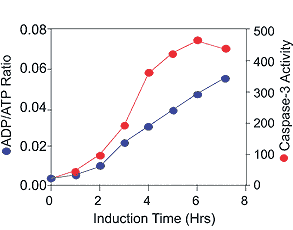The assay is designed to detect ADP/ATP ratio. The changes in ADP/ATP ratios have been used to conveniently differentiate apoptosis from necrosis.
The assay utilizes bioluminescent detection of ADP and ATP levels for rapid screening of apoptosis, necrosis, growth arrest and cell proliferation simultaneously in mammalian cells. The assay utilizes the enzyme luciferase to catalyze the formation of light fom ATP and luciferin. The light can be measured using a luminometer or beta counter. ADP levels are measured by its conversion to ATP that is subsequently detected using the same reaction.
This highly sensitive assay (detects 100 mammalian cells/well) can be fully automated for high throughput measurements. The ADP/ATP ratio assay offers highly consistent results, with excellent correlation to other apoptosis markers (e. g. TUNEL-based techniques and caspase assays).

Figure: Time-dependent induction of apoptosis analyzed by ADP/ATP ratio assay in comparison to caspase-3 activity assay. Apoptosis was induced in Jurkat cells with camptothecin for various hours as indicated. ADP/ATP ratio was analyzed by ApoSENSOR™ ADP/ATP Ratio Assay Kit using 1000 cells per assay. Caspase-3 activity was determined using the Caspase-3 Fluorometric Assay Kit (Prod. No.
ALX-850-216) according to the kit instructions."
Please mouse over
Product Details
| Applications: | Chemiluminescence
|
| |
| Quantity: | 200 assays. |
| |
| Handling: | Protect from light. Avoid freeze/thaw cycles. |
| |
| Shipping: | Dry Ice |
| |
| Long Term Storage: | -20°C |
| |
| Contents: | 50ml Nucleotide Releasing Buffer,
1 vial ATP Monitoring Enzyme (green cap),
1 vial ADP Converting Enzyme (blue cap),
2ml Enzyme Reconstitution Buffer (red cap). |
| |
| Regulatory Status: | RUO - Research Use Only |
| |
Product Literature References
Loss of Peter Pan (PPAN) Affects Mitochondrial Homeostasis and Autophagic Flux: D.P. Dannheisig, et al.; Cells
8, 894 (2019),
Abstract;
Full Text












